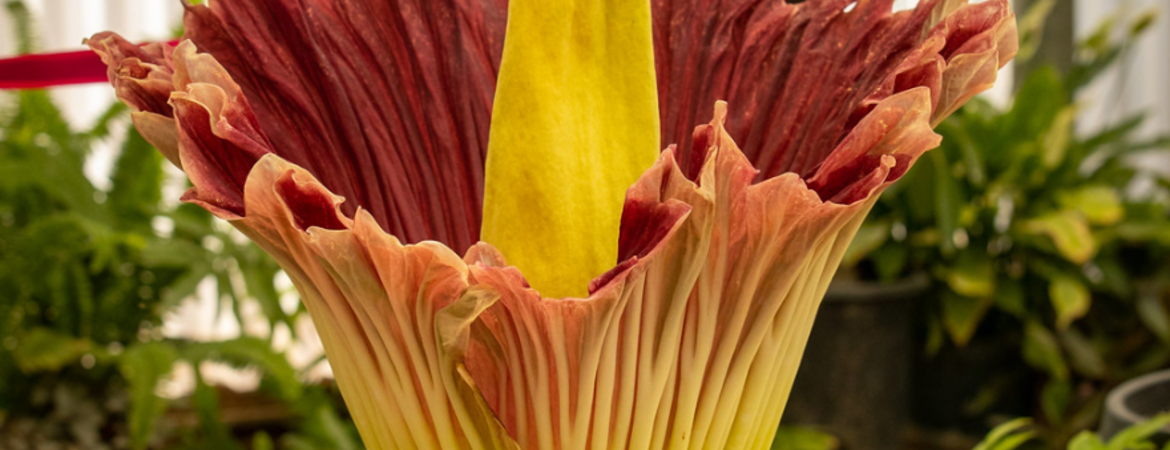
Sunday, July 24, 2022 was a big day for the Botanic Gardens. Almost 1,700 people came to see, and smell, Little Miss Stinky! Although we have several corpse plants (Amorphophallus titanum), and our oldest is from 1995, this was the first time we had one bloom. It’s a rare event, but it’s even more rare that it took this long. Most plants take seven to ten years to bloom but ours took 19 years! Our not so state-of-the-art temperature and humidity control and infrequent fertilizing may have contributed to our plants being late bloomers. Riverside weather is tough on plants that are native to Sumatra, Indonesia, even if they’re in a greenhouse. After the first bloom, it should take less time for subsequent blooms… hopefully. We learned a lot in a very short amount of time that will help us in the future.
Our Little Miss Stinky was given to us in 2007 from the Huntington Botanical Gardens. They had a plant they called Big Stinker bloom in 1999, which was the first time a corpse plant bloomed in California. It bloomed again in 2002 and the pollen was collected, frozen, and given to UC Santa Barbara in 2003 for their bloom. UCSB gave the Huntington some of the offspring to distribute, and we were one of the lucky recipients.
Another common name for this species is titan arum, since it is in the arum family, Araceae. Other members of the arum family that you may be familiar with are calla lilies and anthuriums. Leaves and blooms of these species are produced from an underground corm, a swollen, modified underground stem that stores food. They all have a flowering spadix surrounded by a petal-like bract called a spathe that can be very showy. At the base of the tall spadix, hidden under the beautiful spathe, are hundreds of male and female flowers.
The corpse plant is quite unusual in that it only produces one leaf at a time. What appears to be a trunk is the petiole of the tree-like compound leaf. Miss Stinky’s last leaf was about 10 feet tall and looked like a small palm tree. After a varied amount of time, which could be a few months to over a year, the leaf will die and the plant will be dormant for a few weeks to months. It continues this cycle until the corm has stored enough food to bloom and produce an inflorescence, which is made up of many flowers.
The size of the corpse plant bloom depends on the size of the corm. Little Miss Stinky was only 40 inches tall because the corm was about 20 pounds. In cultivation corms can grow to over 200 pounds and the height of the spadix can reach about 8 feet. The size of the corm increases each year as the leaf photosynthesizes, producing carbohydrate that is stored in the corm. Thus, generally the older the plant is when it blooms, the larger the inflorescence will be.
Little Miss Stinky didn’t give us much warning that she was going to bloom. Or rather, we were just inexperienced. From the time the bracts opened to reveal the spadix to the time it bloomed was only eight days. We scrambled to get things in place so we could share this rare experience with the UCR campus, Friends members, and the public. The BG staff, along with much help from campus, moved with lightning speed to set up cameras and get the word out. Visitors were coming to see Miss Stinky as soon as news went viral. By Friday we had as many as 175 visitors in the greenhouse, Saturday there were 255, and Sunday when she was fully opened there were almost 1,700 visitors. We had no idea so many people would show up. Some of our regular volunteers who came to view Miss Stinky were recruited on the spot to help out with crowd control. Many people pitched in to help, including the UCR Chancellor, Kim Wilcox, and Diane Del Buono.
Corpse plants are so named because of their putrid smell, which attracts their insect pollinators. The stink was the strongest very early Sunday morning and by Monday morning it was gone. The beautiful, deep maroon spathe had nearly closed by then and was removed to be able to collect the pollen. The spathe was given to the UCR herbarium, and some of the pollen was given to Washington State University to pollinate their corpse plant named Titan VanCoug. You can view a time-lapse video of this big event plus read all the press on the CNAS website: https://CNAS.UCR.edu/corpse-plant. Additional information can be found at this link: https://www.chicagobotanic.org/titan/faq